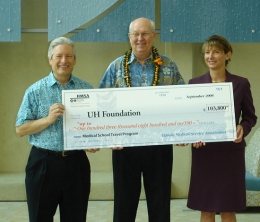Funding will be utilized to "Grow Our Own Healers" on Neighbor Islands
(Honolulu, Hawaiʻi) — The Hawaiʻi Medical Service Association (HMSA) has announced it will provide travel support funding for up to 25 medical students to perform primary care clinical rotations on neighbor islands with the ultimate goal of expanding the number of physicians practicing on the neighbor islands. The HMSA Medical School Travel Support Program will be administered by the Hawaiʻi/Pacific Basin Area Health Education Center (AHEC) program at the John A. Burns School of Medicine (JABSOM) at the University of Hawaiʻi at Mānoa and coordinated with the medical school’s Office of Medical Education. HMSA has committed to providing up to $103,800 in travel support grants this year and will consider renewing the funding for a second year.
"It is important for the medical school to be able to give our students an opportunity to train in rural areas throughout the State, so they can experience firsthand what the health care needs are in these communities and to foster their interest in working in rural areas after they complete their residency training," said Dr. Jill Omori. "Many of our former students who were given the opportunity to train in these rural areas are currently practicing on the neighbor islands and giving back to the communities who helped to teach them. With the rising costs of airfare and housing, it would be very difficult for us to continue our rural training programs without the support from concerned organizations like HMSA." Dr. Jill Omori, Director of Pre-doctoral Education for the Department of Family Medicine & Community Health.
Annually, approximately 15 medical students from JABSOM perform six week rotations on the neighbor islands and another ten perform five month rotations in rural locations. The HMSA Medical School Travel Support Program will help JABSOM offset transportation and housing costs for the students, provide them a stipend for unexpected expenses, and offset travel costs for supervising physicians to attend meetings on Oʻahu. The rotations will be performed in Hilo, Kona, Waimea and Honokaʻa on the Big Island; Kula, Kihei, Kahului, Lahaina and Hana on Maui; and on the islands of Molokaʻi, Lanaʻi and Kauaʻi.
"We’re very pleased to support the travel of UH medical students to the neighbor islands," said Cliff K. Cisco. "The HMSA Medical School Travel Support Program funds travel for up to 25 students per year to perform clerkships in some of Hawaiʻi’s rural areas. Partnerships such as this will certainly provide wonderful experiences for our medical students, and also greater access to care for residents on the neighbor islands." Cliff K. Cisco, HMSA senior vice president.
Former students now practicing on the neighbor islands said the training rotations are critical to attract physicians there. "Someone like me, I’m from Hilo and I knew what to expect and I always knew I wanted to come back," said Dr. Daniel Hudak, a John A. Burns School of Medicine alumnus and general surgeon in Hilo. "But someone from Oahu, for example, might be a little hesitant to set up a practice in Hilo. So having that foot in the door and coming here to experience it and see what life is like, I think would be very important."
The rotations will be coordinated by Dr. Jill Omori and Dr. Damon Lee of JABSOM. HMSA will provide up to $207,600 over a two year period.
"Our medical school is committed to addressing the shortage of physicians who live and practice on the neighbor islands. One of the best ways to do this is to provide our students real-life experiences in working with underserved communities during their medical training," said Dean Jerris Hedges. "We are grateful to HMSA for their willingness to partner with us in giving our students crucial rural training opportunities. The HMSA Medical School Travel Support Program will offset many of the additional travel and living expenses incurred when our students train in these areas. As a result, we hope to expand the number of rural training opportunities available, and thereby increase the number of physicians who choose to practice in these communities." Jerris R. Hedges, MD, MS, MMM, Dean, John A. Burns School of Medicine.

# # #
The Hawaiʻi/Pacific Basin Area Health Education Center (AHEC) is a program within the John A. Burns School of Medicine at University of Hawaiʻi Mānoa that is supported by a grant from the US Department of Health and Human Services, Health Resources and Services Administration. For more information on AHEC, please visit their web site at www.ahec.hawaii.edu.
HMSA is a nonprofit, mutual benefit association founded in Hawaiʻi in 1938. It is governed by a community board of directors that includes representatives from health care, business, labor, government, education, clergy, and the community at large. HMSA is a member of the Blue Cross and Blue Shield Association, an association of independent Blue Cross and Blue Shield plans. Nationally, HMSA and 38 other Blue Cross and Blue Shield plans provide worldwide coverage to more than 100 million members. For more information, please visit hmsa.com.
The John A. Burns School of Medicine, UH Mānoa was established in 1967 as a twoyear program, and became a four-year degree-granting school in 1973. It is Hawaiʻi’s only medical school and has trained almost 2,000 medical doctors to date. Approximately half of the physicians practicing in Hawaii are graduates of the John A. Burns School of Medicine MD or residency program. For more information about JABSOM, please visit jabsom.hawaii.edu.
The University of Hawaiʻi Foundation, a nonprofit organization, raises private funds to support the University of Hawaiʻi System. The mission of the University of Hawaiʻi Foundation is to unite donors' passions with the University of Hawaiʻi’s aspirations by raising philanthropic support and managing private investments to benefit UH, the people of Hawaiʻi and our future generations www.uhfoundation.org.